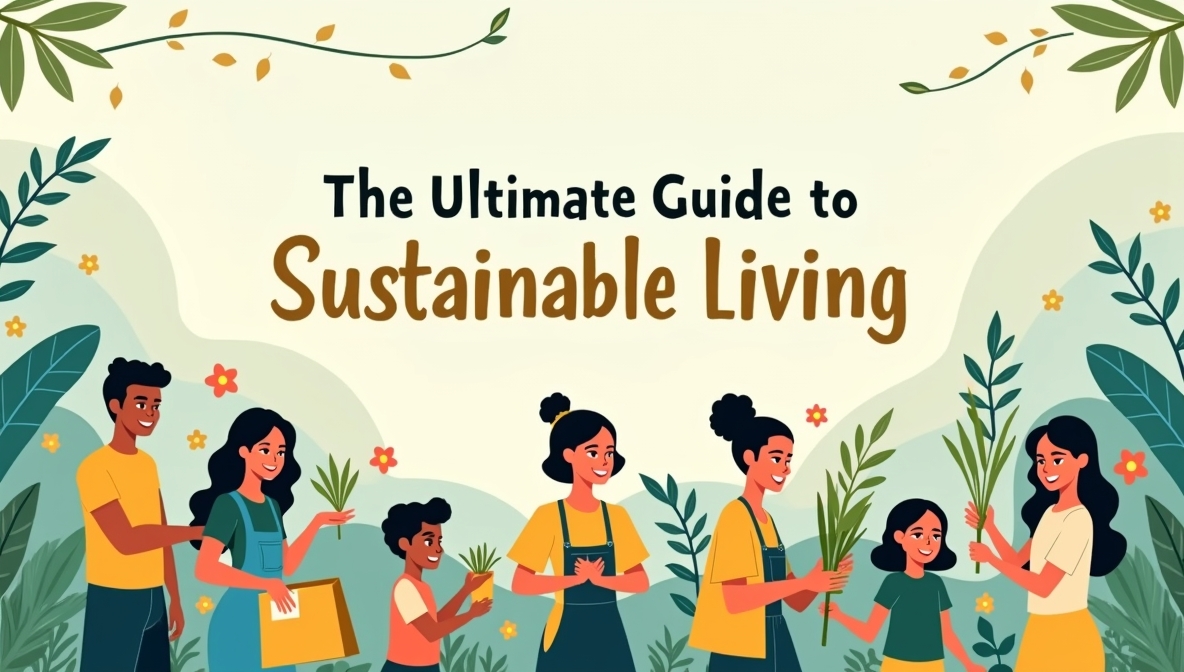Sustainable living has become more than just a trend; it’s a way of life that can help us preserve the planet for future generations. With growing concerns about climate change, pollution, and the depletion of natural resources, making sustainable choices in our daily lives is more important than ever.
While the concept of sustainability can seem overwhelming, it doesn’t have to be. In this guide, we’ll walk you through simple, practical steps you can take to reduce your environmental impact, live more sustainably, and contribute to a greener future.
1. Why Sustainable Living Matters
Sustainable living refers to making choices that help reduce your carbon footprint and minimize your impact on the planet. By adopting eco-friendly habits, you contribute to preserving the Earth’s natural resources, protecting wildlife, and ensuring a cleaner environment for future generations.
Here’s why it matters:
1. Combatting Climate Change
The Earth’s climate is changing, and human activities like burning fossil fuels and deforestation are major contributors. By adopting sustainable practices, such as reducing energy consumption and using renewable resources, you can help mitigate the effects of climate change.
2. Protecting Natural Resources
Many of the resources we rely on, such as water, oil, and minerals, are finite. Sustainable living encourages us to use resources more efficiently and to reduce waste, helping to preserve these valuable assets for future generations.
3. Reducing Pollution
From plastic waste to harmful chemicals, pollution is a major issue that affects both the environment and our health. By adopting sustainable practices, such as reducing plastic use and supporting cleaner technologies, you can help reduce pollution and keep our air, water, and soil clean.
2. Simple Steps to Live More Sustainably
Adopting a sustainable lifestyle doesn’t require drastic changes. Even small changes in your daily habits can make a big difference over time. Here are some easy and effective steps to get started:
1. Reduce, Reuse, and Recycle
The “3 Rs” are the foundation of sustainable living. Start by reducing the amount of waste you create—whether that’s by buying fewer disposable items, choosing products with less packaging, or embracing minimalism. Reuse items whenever possible, and recycle materials like paper, plastic, and glass.
2. Cut Down on Energy Consumption
Saving energy at home is one of the most effective ways to live more sustainably. Here are some simple steps you can take:
Turn off lights when you leave a room.
Unplug electronics when not in use.
Use energy-efficient appliances and LED bulbs.
Insulate your home to reduce heating and cooling costs. By using less energy, you not only lower your carbon footprint but also save money on utility bills.
3. Choose Sustainable Transportation
Transportation is a major contributor to greenhouse gas emissions. If possible, consider these alternatives to reduce your carbon footprint:
Walk or bike for short trips.
Use public transportation or carpool to reduce the number of vehicles on the road.
Drive a fuel-efficient or electric car to cut down on emissions. Opting for sustainable transportation options can reduce air pollution and conserve fossil fuels.
4. Eat a Plant-Based Diet
The food we eat has a significant impact on the environment. Meat production, especially beef and lamb, generates a large amount of greenhouse gases. By eating more plant-based meals, you can help reduce your environmental footprint. Consider these tips:
Eat more vegetables, fruits, grains, and legumes.
Reduce meat consumption or try meatless days.
Choose locally grown and organic food to reduce the environmental cost of transportation and pesticides.
Eating sustainably also means reducing food waste. Plan meals, store food properly, and compost food scraps to minimize waste and create nutrient-rich soil for your garden.
5. Support Eco-Friendly Brands
Another way to live more sustainably is to support businesses that prioritize eco-friendly practices. Look for brands that use sustainable materials, promote fair trade, and take steps to reduce their environmental impact. Supporting these companies encourages others to adopt more sustainable practices.
6. Conserve Water
Water conservation is another essential part of sustainable living. With growing concerns about water scarcity, it’s important to use water efficiently. Here’s how:
Fix leaks in faucets, pipes, and toilets to prevent water wastage.
Install water-efficient fixtures like low-flow showerheads and toilets.
Collect rainwater to water your plants and garden.
Shorten your showers and turn off the tap while brushing your teeth.
Every small effort helps conserve this vital resource.
7. Create a Green Home
Making your home more eco-friendly not only saves money but also reduces your environmental impact. Here are a few ways to make your home greener:
Use natural cleaning products that are free from harmful chemicals.
Opt for eco-friendly furniture made from sustainable materials like bamboo or recycled wood.
Install solar panels if possible, to harness renewable energy.
Create a garden or plant trees to absorb carbon dioxide and promote biodiversity.
8. Get Involved in Sustainability Initiatives
One of the most effective ways to make an impact is to join community efforts focused on sustainability. Whether it’s participating in local clean-up events, supporting environmental charities, or advocating for policies that protect the environment, getting involved in your community can amplify your efforts and help create larger-scale change.
3. The Long-Term Benefits of Sustainable Living
Adopting sustainable practices is not just about helping the planet; it also brings long-term personal and financial benefits:
1. Improved Health
Living sustainably often leads to healthier choices. Eating a plant-based diet, using non-toxic cleaning products, and getting outdoors more can improve both your physical and mental health.
2. Financial Savings
Many sustainable practices, such as reducing energy consumption, conserving water, and minimizing waste, can help you save money in the long run. By investing in energy-efficient appliances, for example, you can reduce your utility bills, while cutting down on waste can reduce your overall spending.
3. A Better Future for Future Generations
By adopting sustainable habits, you contribute to a cleaner, healthier planet for future generations. Your efforts can help preserve natural resources, reduce pollution, and protect biodiversity, ensuring that future generations inherit a world worth living in.
4. Conclusion
Sustainable living doesn’t have to be difficult or overwhelming. By making small, intentional changes to your daily habits, you can significantly reduce your environmental impact and help create a more sustainable future. Whether it’s reducing waste, conserving energy, supporting eco-friendly brands, or getting involved in local sustainability initiatives, every step counts.
Start incorporating these sustainable practices into your life today, and encourage others to do the same. Together, we can build a greener, healthier world for ourselves and future generations.

